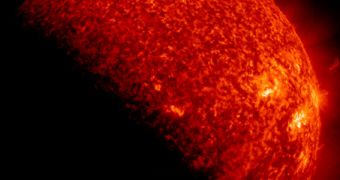Experts at the NASA Goddard Space Flight Center (GSFC), in Greenbelt, Maryland, announce that the Solar Dynamics Observatory (SDO) has just entered the eclipse season. The latter occurs twice every year, around the time of the equinox.
For three weeks around equinoxes, the telescope's view of the Sun – its main science target – is partially obscured by the planet, as visible in the image above. This doesn't mean that SDO can no longer collect images, only that it will not be able to cover the entire solar disk.
This type of eclipses affect most solar observatories, and it “comes with the territory.” The Sun is obscured for most, but not all, of the day, leaving mission controllers some wiggle room in terms of setting up their observation times.
SDO is responsible for studying solar flares, magnetic loops and coronal mass ejections on the Sun, and produces space weather warnings fairly often. It is one of the most sensitive telescopes of its kind.

 14 DAY TRIAL //
14 DAY TRIAL //